Remember, This Way How to Search Engine Optimize Your Blog Content Quickly, Try This
Minggu, 05 Februari 2023

Search engine optimization is incredibly important for marketers. When you optimize your web pages -- including your blog posts -- you're making your website more visible to people who are looking for keywords associated with your brand, product, or service via search engines like Google.
But it can be a pretty tricky tactic to master with Google's copious algorithm updates.
How do you know what matters and what doesn't? What are today's blog SEO best practices, and what's considered "old-school"? How on earth can you keep it all straight?
We understand confusion is a common issue facing inbound marketers -- and we want to help. In this post, we'll cover how to optimize your blog posts for the keywords you care about, along with a few other optimization tactics you should keep in mind.
Note that this list doesn't cover every single SEO tactic under the sun. Rather, these tips are meant to get you started with improving SEO for your blog in particular.
HubSpot customers: If you want to see specific SEO optimization tips for your individual blog posts, click the chart icon on the far left side of the blog editor when you're working on the post to access the SEO Optimization screen.
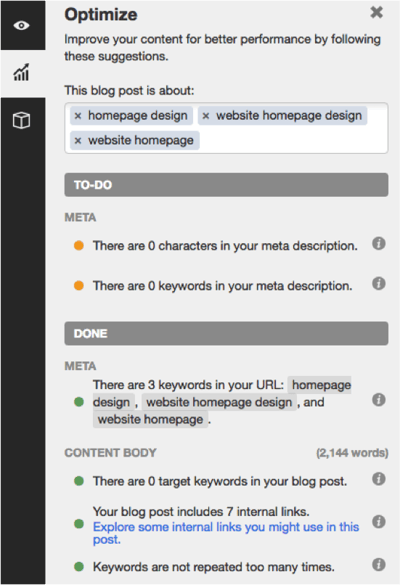
If you're not a customer, you can use these tips as a sort of checklist as you blog.
(Want to learn more about content creation, strategy, and promotion? Sign up here to be the first in line for our new Content Marketing Certification course.)
How to Search Engine Optimize Your Blog Content
1) Focus on 1–2 long-tail keywords.
Optimizing your blog posts for keywords is not about incorporating as many keywords into your posts as possible. Turns out that'll actually hurt your SEO because search engines will think you're keyword stuffing (i.e., including your keywords as much as possible with the sole purpose of gaining ranking in organic search).
But that's not cool with search engines, nor does it make for a very good reader experience. Instead, you should use keywords in your content in a way that doesn't feel unnatural or forced.
A good rule of thumb is to focus on one or two keywords per blog post. This'll help keep you focused on a goal for your post. While you can use more than one keyword in a single post, keep the focus of the post narrow enough to allow you to spend time actually optimizing for just one or two keywords.
Using long-tail keywords may be more efficient to this end, since website visitors searching long-tail terms will often be more qualified. In other words, you'll bring in the right type of traffic -- visitors who convert -- by using long-tail keywords.
How do you know which keywords to use? My colleague Rachel Sprung wrote this great blog post on how to do keyword research, which lays out a keyword research process you can follow to help come up with and narrow down a list of terms you should be targeting.
2) Include these 1–2 keywords in specific parts of your post.
Now that you've got your one or two keywords, it's time to incorporate them into your blog post. Where are the best parts of your posts to include these terms so you rank high in search results?
There are four essential places where you should try to include your keywords: headline, headers and body, URL, and meta description.
a) Title
The title (i.e., headline) of your blog post will be a search engine's and reader's first step in determining the relevancy of your content, so including a keyword here is vital.
Be sure to include your keyword within the first 65 characters of your headline, which is just about where Google cuts it off on search engine results pages (SERPs). Technically, Google measures by pixel width, not character count, and it recently increased the pixel width for organic search results from approximately 500 pixels to approximately 600 pixels, which translates into around 65 characters.
Long title? When you have a lengthy headline, it's a good idea to get your keyword in the beginning since it might be cut off in SERPs towards the end, which can take a toll on your post's perceived relevancy. In the example below, we had a long title that went over 65 characters, so we front-loaded it with the keyword we were trying to rank for: "on-page SEO."

b) Headers & Body
Mention your keyword at a normal cadence throughout the body of your post and in the headers. That means including your keywords in your copy, but only in a natural, reader-friendly way. Don't go overboard at the risk of being penalized for keyword stuffing. Before you start writing a new blog post, you'll probably think about how to incorporate your keywords into your post. That's a smart idea, but it shouldn't be your only focus, nor even your primary focus.
Whenever you create content, your primary focus should be on what matters to your audience, not how many times you can include a keyword or keyword phrase in that content. Focus on being helpful and answering whatever question your customer might have asked to arrive on your post. Do that, and you'll usually find you naturally optimize for important keywords, anyway.
c) URL
Search engines also look to your URL to figure out what your post is about, and it's one of the first things it'll crawl on a page. You have a huge opportunity to optimize your URLs on every post you publish, as every post lives on its own unique URL -- so make sure you include your one to two keywords in it.
In the example below, we created the URL using the long-tail keyword we were trying to rank for: "email marketing examples."

d) Meta Description
Later in this post, we'll dive into explaining meta descriptions. Your meta description is meant to give search engines and readers information about your blog post's content -- so be certain to use your long-tail term so Google and your audience are clear on your post's content. At the same time, keep in mind that the copy matters a great deal for click rates -- the more engaging, the better.
3) Make sure your blog is mobile-friendly.
It's been over a year since Google revealed that more people use the search engine on their mobile phones than on desktop. And for all those valuable search queries being done on mobile, Google displays the mobile-friendly results first. This is yet another example of Google heavily favoring mobile-friendly websites, which has been true ever since the algorithm updates of April 2015 and March 2016.
Notice how the mobile-friendly examples are listed first when I search for the best restaurants in Fort Myers on my phone. In fact, there are zero search results that aren't mobile-friendly on the first page of my search results.
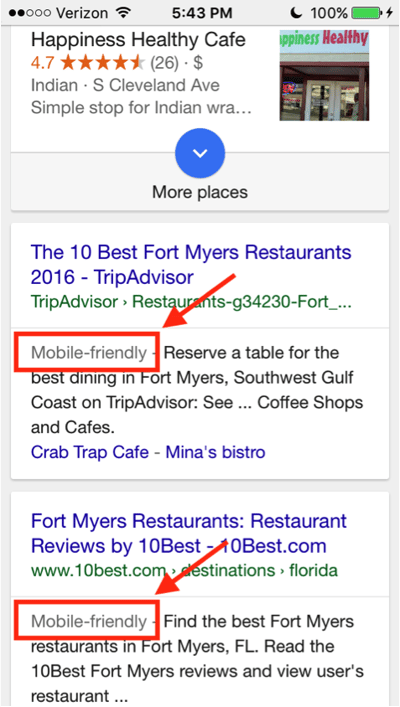
While responsive design and mobile-friendly websites have always been important for user experience, they're becoming more and more important for SEO as well. So if you haven't been focusing on improving your mobile experience, you'd better prioritize it now, or your search rankings could suffer.
(HubSpot customers: Breathe easy. All content created on HubSpot's platform is automatically responsive to mobile devices.)
If your website uses responsive design, your blog pages will only have one URL instead of two different ones -- for desktop and mobile, respectively. This helps your post's SEO because any inbound links that come back to your site won't be divided between the separate URLs. Any SEO power you gain from these links will be centralized, helping Google more easily recognize your post's value and rank it accordingly.
Pro tip: What search engines value is constantly changing. Be sure you're keeping on top of these changes by subscribing to Google's official blog.
4) Optimize the meta description.
To review, a meta description is the additional text that appears in SERPs that lets readers know what the link is about. The meta description gives searchers information they need to determine whether or not your content is what they're looking for, and ultimately helps them decide if they'll click or not.
In addition to being reader-friendly (compelling and relevant), your meta description should include the long-tail keyword you are trying to rank for, because if we're doing blogging right, that keyword is representative of the contents of your post.

In the example above, I searched for "newsletter examples." The term is bolded in the meta description -- helping readers make the connection between their search term and the result -- and the copy "get inspired" catches attention and compels clicks.
Note: Nowadays, it's not guaranteed that your meta description is always pulled into SERPs as it once was. More and more, Google has been pulling in other parts of your blog post that includes the keywords searched, presumably to give searchers optimal context around how the result matches their specific query.
Let me show you what I mean. Below is an example of two different search queries delivering two different snippets of text on Google SERPs. The first is a result of the query "no index no follow," and pulls in the original meta description:

The second is a result of the query "noindex nofollow," and pulls in the first instance of these specific keywords coming up in the body of the blog post:

While there's not much you can do to influence what text gets pulled in, you should continue to optimize your post for readability (see above). By creating reader-friendly content with natural keyword inclusion, you'll make it easier for Google to prove your post's relevancy in SERPs for you.
5) Optimize your images.
Blog posts shouldn't only contain text -- you should also include images that help explain your content. But search engines don't just look for images. Rather, they look for images with alt text.
Because search engines can't "see" images the same way humans can, an image's alt text tells them what an image is about -- which ultimately helps those images be found in search. Alt text also makes for a better user experience, as it'll display inside the image container when an image can't be found or displayed, and can also improve accessibility for people with poor vision who are using screen readers.
Technically, alt text is an attribute that can be added to an image tag in HTML. Here's what a complete image tag might look like (bolding added for emphasis):
<img class="alignCenter shadow" src="image.jpg" alt="image-description" title="image tooltip">
Adding keywords to your alt text may seem minor -- and it isn't going to impact your search rankings as much as other things on this list. But it is worth the extra minute it takes to change the name from "IMG23940" to something accurate and descriptive, like "puppies-playing-in-basket:"

Read this blog post to learn more on-page SEO tips for keyword optimizing the most critical parts of your website.
HubSpot customers: The SEO Panel will recognize whether or not you have optimized your images. Though these elements are not as important as some other optimizations, they're still necessary (not to mention easy to add).

6) Don't use too many similar topic tags.
Topic tags can help organize your blog content, but if you overuse them, they can actually be harmful. If you have too many similar tags, you may get penalized by search engines for having duplicate content.
Think of it this way: When you create a topic tag, you also create a new site page where the content from those topic tags will appear. If you use too many similar tags for the same content, it then appears to search engines as if you're showing the content multiple times throughout your website. For example, topic tags like "blogging," "blog," and "blog posts" are too similar to one another to be used on the same post.
If you're worried that your current blog posts have too many similar tags, take some time in the near future to clear them up. Choose about 15–25 topic tags that you think are important to your blog and that aren't too similar to each other, and then only tag your posts with those keywords. That way, you won't have to worry about duplicate content.
7) Use URL structures that help your visitors.
The URL structure of your web pages (which are different from the specific URLs of your posts) should make it easy for your visitors to understand the structure of your website and the content they're about to see. Search engines favor web page URLs that make it easier for them and website visitors to understand the content on the page.
For instance, let's take a look at HubSpot's main blog page, which lives at http://blog.hubspot.com/. When you look at the site itself, you'll see there are two blog sections -- Marketing and Sales -- each containing many different blog posts.
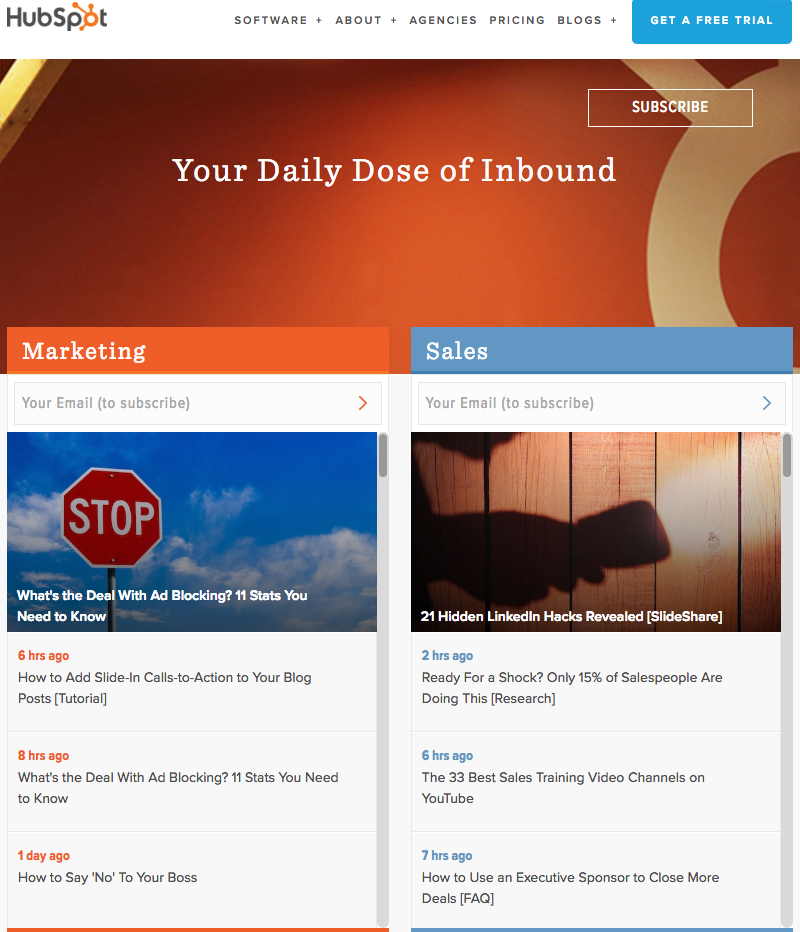
This visual differentiation is also baked into the blog's URL structure. If I decided to go to the Marketing section from this main page, I would be taken to the URL http://blog.hubspot.com/marketing. If we want to read the Sales section, all we have to do is change where it says "marketing" in the URL to "sales": http://blog.hubspot.com/sales. This URL structure helps me understand that "/marketing" and "/sales" are smaller sections within the larger blog.
What if there's a specific article we want to read -- perhaps "How to Do Keyword Research: A Beginner's Guide"? Its URL structure -- http://blog.hubspot.com/marketing/how-to-do-keyword-research-ht -- denotes that it's an article from the Marketing section of the blog.
In this way, URL structure acts as a categorization system for readers, letting them know where they are on the website and how to access new site pages. Search engines appreciate this, as it makes it easier for them to identify exactly what information searchers will access on different parts of your blog or website.
Get more best practices for URL structure from Moz here.
8) Link internally when possible.
Inbound links to your content help show search engines the validity or relevancy of your content. The same goes for linking internally to other pages on your website. If you've written about a topic that's mentioned in your blog post on another blog post, ebook, or web page, it's a best practice to link to that page.
You might've noticed that I've been doing that from time to time throughout this blog post when I think it's helpful for our readers. Not only will internal linking help keep visitors on your website, but it also surfaces your other relevant and authoritative pages to search engines.
HubSpot customers: The SEO Panel automatically suggests linking to other internal resources on your website. Think of it as solving for your SEO while also helping your visitors get more information from your content.
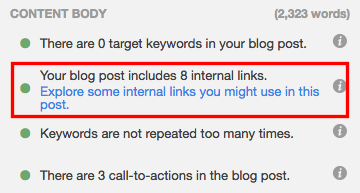
If you're looking for more internal links to add to your post but aren't sure which would be relevant, you can click "Explore some internal links you might use in this post" for a list of recommendations.
9) Use Google's Search Console.
Google's free Search Console contains a section called the Search Analytics Report. This report helps you analyze clicks from Google Search, and it's useful to determine which keywords people are using to find your blog content. Learn how to use it by reading this blog post written by my colleague Matthew Barby and by reading Google's official support page here.
If you're interested in optimizing your best-performing older blog posts for traffic and leads like we've been doing since 2015, this tool can help identify low-hanging fruit.
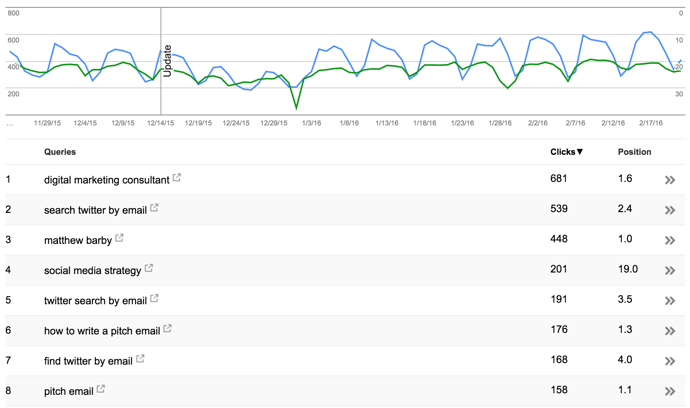
A lot of content marketers struggle with optimizing their blog posts for search. The truth is, your blog posts won't start ranking immediately. It takes time to build up search authority. But when you publish blog posts frequently and consistently optimize them for search while maintaining a reader-friendly experience, you'll reap the rewards in the form of traffic and leads long-term.
What tips do you know that can help make blog posts SEO-friendly? Share your advice below.
Sourche: http://blog.hubspot.com/
